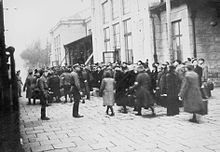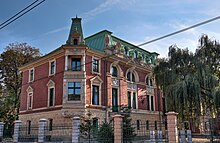|
Sosnowiec
Sosnowiec[a] is an industrial city county in the Dąbrowa Basin of southern Poland, in the Silesian Voivodeship, which is also part of the Metropolis GZM municipal association.[5] Located in the eastern part of the Upper Silesian Industrial Region, Sosnowiec is one of the cities of the Katowice urban area, which is a conurbation with a total population of 2.7 million people; as well as the greater Katowice-Ostrava metropolitan area populated by about 5.3 million people.[6] The population of the city is 189,178 as of December 2022.[7] Geography It is believed that the name Sosnowiec originates from the Polish word sosna, referring to the pine forests growing in the area prior to 1830. The village was originally known as Sosnowice. Other variations of the name include Sosnowietz, Sosnowitz, Sosnovitz (Yiddish), Sosnovyts, Sosnowyts, Sosnovytz, Sosnowytz, and Sosnovetz. There are five other smaller settlements in Poland also called Sosnowiec, located in the Kielce Voivodship, Łódź Voivodship, and Opole Voivodship. Sosnowiec serves as one of the administrative centres of the geographical and historical area of southern Poland known as the Zagłębie Dąbrowskie (the Dąbrowa Basin). It lies within the historic Lesser Poland region near the border with Silesia. It is located about 10 km (6.2 mi) north-east to the centre of Katowice and 65 km (40 mi) north-west of Kraków, situated in the Silesian Upland on the rivers Brynica and Przemsza, a tributary of the Vistula. The full list of rivers includes Biała Przemsza as well as Czarna Przemsza, Brynica, Bobrek, and Potok Zagórski creek. The city is part of the Silesian Voivodeship since its formation in 1999. Previously (since 1945), it was part of Katowice Voivodeship, and before World War II, Sosnowiec belonged to Kielce Voivodeship. HistoryEarly history The history of the city begins in 1902 when it was granted city rights after the merger a number of older settlements. However, the history of the village of Sosnowiec dates back to the year 1227, when it was mentioned for the first time. It was a small settlement in the Polish Duchy of Kraków, located in close vicinity of much larger and better-developed villages of Sielce and Zagórze (both are now districts of the city). Other districts are even older. Milowice was first mentioned in 1123 as Miley. Documents from 1228 already mention Milowice, Klimontów, and Zagórze. Furthermore, Milowice was placed on a 1561 map.[citation needed] As part of the Polish–Lithuanian Commonwealth, Sosnowiec belonged to Kraków Voivodeship in the larger Lesser Poland Province. It became a border town after the neighbouring Duchies of Silesia passed to the Bohemian Crown in 1335. In the result of the third partition of Poland in 1795, however, it was seized by the Kingdom of Prussia and was included into the newly established province of New Silesia. During the Napoleonic Wars, it became part of the Duchy of Warsaw in 1807 and later, of Congress Poland ruled by the namiestniks of the Russian Empire. Located at the borders with the German Empire and Austria-Hungary, Sosnowiec became famous for the Three Emperors' Corner tripoint, which was located within current limits of the city. During the January Uprising, in February 1863, the Battle of Sosnowiec was fought, in which Polish insurgents led by Apolinary Kurowski defeated the Russians.[8] The victory allowed the Poles to take control of the surrounding towns as well.[8] City rights With effect from 10 June 1902, by the order of Emperor Nicholas II of Russia, Sosnowiec was legally named a city with the area of 19 square kilometres (7 sq mi) and with 60,000 inhabitants. Obtaining the city rights helped the economic and cultural development of the town. Apart from steelworks and coal-mines and many enterprises of heavy and light industry, new cultural and social establishments were opened as well. The newly established town consisted of the districts of Sosnowiec, Pogoń, Ostra Górka, Sielec, Kuźnica and Radocha, all of which had been separate villages before. The very fact that Russian authorities waited for so long to grant Sosnowiec town rights is seen as a punishment for local support for the Polish January Uprising 1863/64, after which numerous towns had seen their status, and were reduced to a village status. Sosnowiec was the first post-1860s location in Congress Poland to have received town charter, the second being Puławy in 1906.[citation needed] Natural resources and a good geographical location had an important influence on the development of Sosnowiec. The opening of a branch line of the Warsaw-Vienna Railway in 1859 was vitally important for the growth of the town. Development of industry with the new factory of rope and wire, rolling mill, steelworks, iron foundry, steam boilers factory, and later spinning mill, dye-house and paper mill sealed the new image of the town as entirely urban. The Summer Theatre and, in 1887, the Winter Theatre were founded, the second of which was called City Theatre from 1924 in independent Poland, and later the Theatre of Zagłębie. In 1915, the village of Środula was incorporated into Sosnowiec. Poland finally regained independence in 1918, after World War I. In the Second Polish Republic, Sosnowiec became part of the Kielce Voivodeship, and in 1934 the City County of Sosnowiec was established. Sosnowiec suffered war damages during both major military conflicts in the 20th century: World War I, which caused mainly destruction to industry, and World War II, which brought about the terror of executions.[citation needed] World War II After the 1939 Invasion of Poland, which started World War II, the city was occupied by Nazi Germany and renamed Sosnowitz. On September 4, 1939, German troops murdered 10 Poles, including 15-year-old boy Henryk Słomka, in Sosnowiec in revenge for Polish defense.[9] Around the same time, the Germans murdered nine Poles in nearby Klimontów (present-day district of Sosnowiec).[9] The Einsatzgruppe zbV entered the city on September 12, 1939.[10] The German police carried out mass searches of Polish houses.[11] Initially under military administration set up as part of the General Government, Sosnowiec was annexed by Germany and incorporated into the Province of Silesia on 20 November 1939. In March 1940, the Germans established a transit camp (Gefangenensammellager) for arrested Poles in Sosnowiec.[12] Inhabitants of Sosnowiec were also among Poles murdered in Celiny in June 1940.[13] The Germans operated three labour subcamps of the Stalag VIII-B/344 prisoner-of-war camp in the city, and two more in the present-day district of Klimontów.[14] The Polish underground resistance movement was active in the city.[citation needed]  In June 1943 thousands of Jews were deported from Sosnowiec Ghetto to the Auschwitz concentration camp. The ghetto was liquidated two months later and almost all remaining Jews (around 15,000) were also deported to Auschwitz. Previously there had been considerable underground activity among them. The Germans established and operated two subcamps of the Auschwitz concentration camp in the city. In the first subcamp they held about 100 Polish forced labourers,[15] and in the second, larger, they held hundreds of forced labourers, initially mostly Jews.[16] In 1944, the Germans sent kidnapped Polish children from Sosnowiec to the Potulice concentration camp.[17] The Vistula–Oder Offensive of the Red Army in January 1945 brought about the liberation of the city.[citation needed] Post-war After World War II, Sosnowiec further developed. On June 1, 1975, the metropolitan area was expanded when the neighbouring locations of Zagórze, Kazimierz Górniczy, Porąbka, Klimontów, and Maczki, became its districts. By 1977 the population of the city reached 200,000. Further growth was accelerated by the construction of Katowice Steelworks, and in 1981, the population of Sosnowiec was 250,000, reaching its peak in 1987, when it was 259,000. Since then, the population has been declining. In 1992, the city became the seat of the Roman Catholic Diocese of Sosnowiec. Economy Sosnowiec is characterised by its urban dynamics, economic activity, cultural heritage, and natural environment. In recent years, Sosnowiec was further developed from an industrial centre (with mainly mining and heavy industries) into a hub of trade and services. Nevertheless, it still operates several important coal mines, steel factories and other industrial plants. Its Special Economic Zone, established in Sosnowiec thanks to the efforts of local authorities, plays a major role in attracting new businesses into the area. As a result, several companies with Polish and foreign capital opened their businesses in the city. Sosnowiec City Office was awarded the ISO 9001 2001 quality certificate for its management system for providing services for the local community. Demographics
Districts  For Sosnowiec's 100th birthday, the downtown area was thoroughly rebuilt, to harmonise its architectural layout and give the city a more modern image. In 2004 Sosnowiec authorities and designers were awarded the Grand Prix for the rebuilding of the downtown area in a competition for the best public space in the Śląskie Provinces. This investment had been accompanied by a program designed to improve the esthetic qualities of the city, under which a comprehensive program for unifying the colors of the elevations, and advertisements entitled “rainbow city” were introduced. Among the city districts there are:
Points of interest  There are many relics of the industrial era, especially residences of industrialists. Most of them are located outside the strict city center, on the Czarna Przemsza river bank. One of the oldest is a 17th-century castle known as the Sielecki Castle. Other main tourist attractions include:[22][23]
Parks and gardensSosnowiec has more than 2,250 ha of green areas occurring as parks, squares, protection zones, lot gardens and forests. In the area of the city preserved many parks established at the residence of industrialists, and also created a lot of new. Many of them present historical and natural value. Main parks and green areas include the Sielec Park, which is a historical park at the castle with many natural monuments; the historical Dietel Park; the Park-Palace Complex of Schöen with two palaces; the Millennium Park, the Środula Park with a sports complex; the nature park "Szopienice-Borki"; as well as the peat bog "Bory" protected area, part of Natura 2000. Education and science Institutions of higher learning in Sosnowiec include:
Among general secondary level schools in Sosnowiec there are high-schools such as the II Liceum Ogólnokształcące im. Emilii Plater, III Liceum Ogólnokształcące im. Bolesława Prusa, and IV Liceum Ogólnokształcące im. Stanisława Staszica. Sports
Notable people 
International relationsConsulatesThere is an Honorary Consulate of Bangladesh in Sosnowiec.[27] Twin towns – sister cities Sosnowiec is twinned with:[28]
Notes
References
External linksWikimedia Commons has media related to Sosnowiec.
|
||||||||||||||||||||||||||||||||||||||||||||||||||||||||||||||||||||||||||||||||||||||||||||||||||||||










